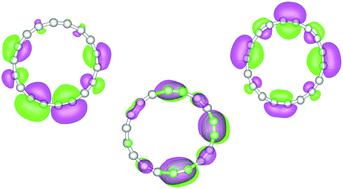当前位置:
X-MOL 学术
›
Phys. Chem. Chem. Phys.
›
论文详情
Our official English website, www.x-mol.net, welcomes your
feedback! (Note: you will need to create a separate account there.)
Non-equilibrium steady state conductivity in cyclo[18]carbon and its boron nitride analogue
Physical Chemistry Chemical Physics ( IF 2.9 ) Pub Date : 2020-10-19 , DOI: 10.1039/d0cp04172f Alexandra E. Raeber 1, 2, 3, 4 , David A. Mazziotti 1, 2, 3, 4
Physical Chemistry Chemical Physics ( IF 2.9 ) Pub Date : 2020-10-19 , DOI: 10.1039/d0cp04172f Alexandra E. Raeber 1, 2, 3, 4 , David A. Mazziotti 1, 2, 3, 4
Affiliation

|
A ring-shaped carbon allotrope was recently synthesized for the first time, reinvigorating theoretical interest in this class of molecules. The dual π structure of these molecules allows for the possibility of novel electronic properties. In this work we use reduced density matrix theory to study the electronic structure and conductivity of cyclo[18]carbon and its boron nitride analogue, B9N9. The variational 2-RDM method replicates the experimental polyynic geometry of cyclo[18]carbon. We use a current-constrained 1-electron reduced density matrix (1-RDM) theory with Hartree–Fock molecular orbitals and energies to compute the molecular conductance in two cases: (1) conductance in the plane of the molecule and (2) conductance around the molecular ring as potentially driven by a magnetic field through the molecule's center. In-plane conductance is greater than conductance around the ring, but cyclo[18]carbon is slightly more conductive than B9N9 for both in-the-plane and in-the-ring conduction. The computed conductance per molecular orbital provides insight into how the orbitals—their energies and densities—drive the conduction.
中文翻译:

环[18]碳及其氮化硼类似物的非平衡稳态电导率
最近首次合成了一种环状碳同素异形体,重新激发了对此类分子的理论兴趣。这些分子的双重π结构允许出现新的电子性质。在这项工作中,我们使用降低密度矩阵理论研究环[18]碳及其氮化硼类似物B 9 N 9的电子结构和电导率。变型2-RDM方法复制了环[18]碳的实验多联几何。我们使用具有Hartree-Fock分子轨道和能量的受电流限制的1电子降密度矩阵(1-RDM)理论来计算两种情况下的分子电导:(1)分子平面中的电导和(2)电导可能是由穿过分子中心的磁场驱动的。平面内电导大于环上的电导,但是对于平面内和环内电导,环[18]碳的导电性均比B 9 N 9略高。通过计算得出的每个分子轨道的电导率,可以深入了解轨道(其能量和密度)如何驱动电导。
更新日期:2020-10-19
中文翻译:

环[18]碳及其氮化硼类似物的非平衡稳态电导率
最近首次合成了一种环状碳同素异形体,重新激发了对此类分子的理论兴趣。这些分子的双重π结构允许出现新的电子性质。在这项工作中,我们使用降低密度矩阵理论研究环[18]碳及其氮化硼类似物B 9 N 9的电子结构和电导率。变型2-RDM方法复制了环[18]碳的实验多联几何。我们使用具有Hartree-Fock分子轨道和能量的受电流限制的1电子降密度矩阵(1-RDM)理论来计算两种情况下的分子电导:(1)分子平面中的电导和(2)电导可能是由穿过分子中心的磁场驱动的。平面内电导大于环上的电导,但是对于平面内和环内电导,环[18]碳的导电性均比B 9 N 9略高。通过计算得出的每个分子轨道的电导率,可以深入了解轨道(其能量和密度)如何驱动电导。











































 京公网安备 11010802027423号
京公网安备 11010802027423号